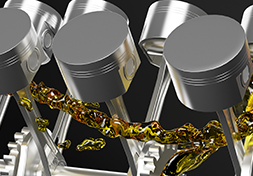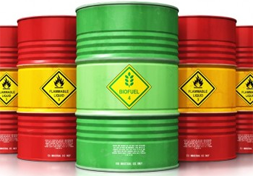After years of accumulation, the Shanghai Research Institute of Sinopec Lubrican...
detailsWater is the most important and most complex pollutant encountered by lubricating oil during use, and its pollution mechanism is still under study. Since the lubricating oil itself has a certain water absorption, the working conditions and the environment will have a non-negligible impact on it.
In the environment and working conditions where the lubricating oil is used, the phenomenon of water ingress is inevitable, and most of the lubricating oil will undergo physical or chemical changes. In extreme cases, it will have very serious consequences for equipment lubrication. Therefore, the focus of lubricating oil in use in the process of equipment lubrication management should be on reducing or controlling the entry of moisture, determining whether moisture exists and detecting its content, and separating and removing moisture as soon as possible.
First, the existence of water in lubricating oil
There are three forms of water in lubricating oil, namely dissolved water, emulsified water and free water. Dissolved water refers to the chemical reaction between water molecules and oil molecules, so that they are uniformly dispersed in the lubricating oil in the form of molecules. This form of water is invisible to the naked eye and does not have a significant impact on the appearance of the lubricating oil. It still maintains a clear and transparent state; emulsified water exists in an emulsified state when the amount of water entering the lubricating oil exceeds a certain amount, making the appearance of the oil appear foggy, turbid or even emulsion-like; free water is when the amount of water entering the lubricating oil continues. When the amount of oil increases, or the oil has a strong demulsification ability, water will be precipitated from the lubricating oil and exist in a free state, which can be observed with the naked eye, which is commonly referred to as "clear water".
The amount of water dissolved in the lubricating oil depends on the type of base oil, the degree of refinement, the amount and polarity of additives, the degree of degradation of the oil in use, the viscosity of the oil and the temperature of use. For example, under normal circumstances, the water absorption of ester base oil is stronger than that of hydrocarbon base oil, the water absorption of type I base oil is stronger than that of type III base oil, the water absorption of internal combustion engine oil and gear oil is stronger than that of hydraulic oil and turbine oil. Larger lubricating oils in use have stronger water absorption than those just put into use, lubricating oils with higher operating temperatures have stronger water absorption than lubricating oils with lower operating temperatures, and lubricating oils with high viscosity are more absorbent than those with lower viscosity. of lubricating oil.
The relationship between water solubility and viscosity of lubricating oil and temperature
The impact of water pollution
The most basic requirement of lubricating oil in the process of storage, transportation and use is "clean", dry without water, clean without dust. Studies have shown that the water content of 500ug/g can significantly shorten the service life of equipment and lubricating oil, which shows the degree of influence of water on the performance of lubricating oil and the importance of waterproofing.
The direct impact of water on the equipment is to cause rust and corrosion to accelerate wear and tear. Water entering the lubricating oil will change the viscosity of the oil and reduce the strength of the oil film. The basic properties such as detergency and dispersibility are weakened or even lost, resulting in poor anti-foaming properties of the oil, resulting in a large amount of foam in the lubrication system, which reduces the lubrication effect, and also leads to cavitation and hydrogen embrittlement of metal materials.
The following is an analysis of the above hazards one by one:
Rust and Corrosion: Usually, water is involved in rust, and even dissolved water in lubricating oil will affect rust. Water will directly react chemically with the metal surface to form oxides, and it will also work with acidic compounds in the oil. The action causes corrosion of the metal surface, accelerating wear in the presence of abrasive particles, and the rust and corrosion particles themselves are typical wear particles, while the flashing of free water on the hot metal surface can cause pitting corrosion.
Reduced oil film strength: In addition to certain viscosity-temperature characteristics, lubricating oil also has certain viscosity-pressure characteristics, that is, when the operating pressure increases, the viscosity of the lubricating oil will also increase, which has a certain protective effect on the friction pair, but Water does not have such characteristics, and its viscosity changes very little with the change of pressure, so when the water enters the lubricating oil, the viscosity and pressure characteristics of the lubricating oil are weakened, so that the friction pair will produce contact fatigue and lead to fatigue wear (in the ferrography analysis). typical fatigue peeling).
Additive failure: water is a highly polar solvent-based compound, and most of the additives in lubricating oil are also polar compounds. According to the principle of similar compatibility, once water enters the lubricating oil, it will interact with these polar compounds. Additives react, on the one hand, make them hydrolyzed or accelerate their consumption and lose their effect, especially functional agents such as antioxidants, extreme pressure antiwear agents, detergents, anti-emulsions, rust inhibitors, etc., and will produce insoluble matter to block the filter. On the other hand, it will be lost in the process of water separation in the lubrication system, which will accelerate the degradation of oil oxidation stability and cause environmental pollution.
Oil foaming: Water entering the lubricating oil will reduce the surface tension of the oil, thereby deteriorating the air release and defoaming properties of the oil, resulting in the oil entrained air and foaming. If the air entrained in the oil cannot be released in time or The formation of stable foam on the surface will further accelerate the oxidation of the oil, and will also greatly reduce the heat transfer performance, oil film strength, fluidity and other properties of the oil.
Mildewing of lubricating oil: Water is a promoter for the growth of microorganisms such as bacteria and fungi. If it exists in lubricating oil for a long time, a large amount of microorganisms will be produced and suspended in the oil, which will cause the oil to produce odor or block the filter. Moreover, microorganisms themselves or their metabolites are also corrosive to a certain extent.
Water vapor cavitation: If water vapor reaches the low pressure area of the lubrication system, the bubbles of water vapor will expand and disperse in the oil, and when it suddenly enters the high pressure area, it will explode instantly, similar to micro-dieselization, impact friction The pair causes cavitation on the surface.
Hydrogen embrittlement: Hydrogen embrittlement is a hot area of research in tribology at present, and the source of hydrogen may be water, or it may be generated by electrolysis and corrosion under the action of water. When free radicals and metals are in contact, under high pressure, water will crack to generate hydrogen, and hydrogen embrittlement will accelerate the further cracking of microscopic cracks and lead to final wear.
Water washing effect: For grease, water pollution will cause the grease to become soft and lost, resulting in dry grinding or loss of sealing performance of the lubrication system due to lack of grease.
The presence of moisture will promote the oxidation and deterioration of oil products, destroy the oil film formed by the lubricating oil, accelerate the corrosion of organic acids to metals, and accelerate the wear of mechanical parts; moisture will also cause additives (especially metal salts) to undergo hydrolysis reactions and fail. , produce precipitation, block the oil circuit, hinder the circulation and supply of lubricating oil. When the temperature is low, the moisture in the lubricating oil will cause the lubricating oil to have poor fluidity and viscosity-temperature; when the temperature is high, the water will vaporize, destroy the oil film and generate air resistance, which will affect the circulation of the lubricating oil. There are many cases of accidents caused by water entering lubricating oil. One of the focuses of equipment lubrication management is to regularly monitor and determine the existence and quantity of water, as well as control the entry of water and separate and remove it as soon as possible.







